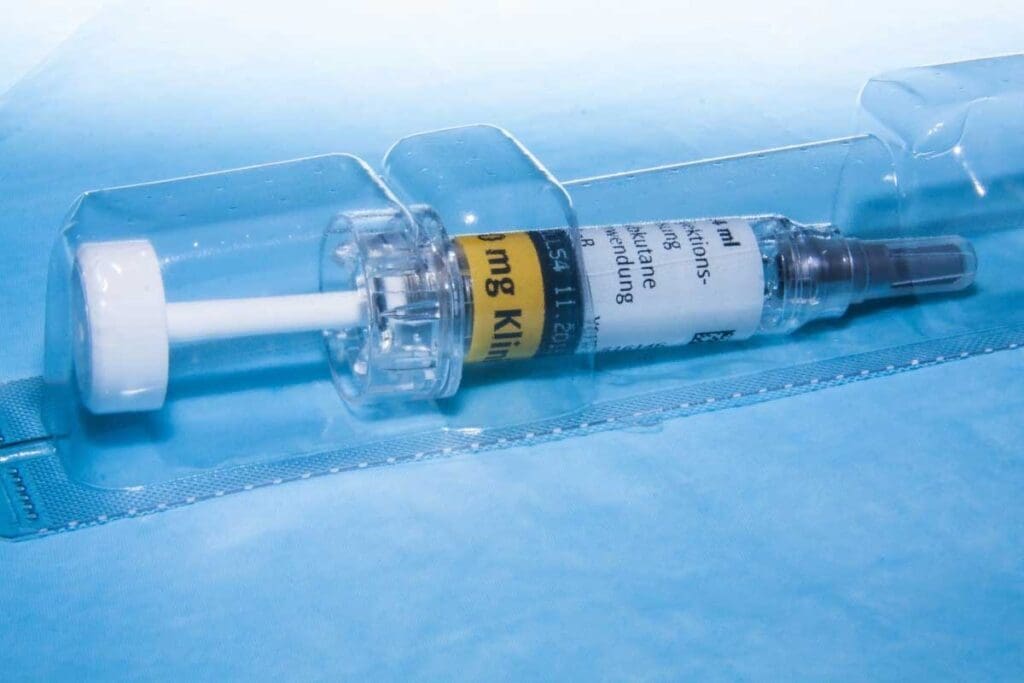Last Updated on November 17, 2025 by Ugurkan Demir
Life-threatening blood clots need quick and effective prevention. For millions, enoxaparin injections in the abdomen are a trusted choice.
At Liv Hospital, we focus on trust and patient care. We use enoxaparin to stop deep vein thrombosis (DVT) and pulmonary embolism (PE). This is after surgery or during hospital stays.

We choose enoxaparin, a low molecular weight heparin, to fight blood clots. This method is safe and shows our dedication to top-notch healthcare.
Anticoagulant injections, like enoxaparin, are key in stopping blood clots. They are given under the skin, usually in the stomach. They help prevent clots in people having surgery or with certain health issues.
These injections stop blood clots from forming or growing. Enoxaparin sodium injection is a low molecular weight heparin. It works by helping antithrombin III to stop clotting factor Xa, preventing clots. Their main goal is to lower the risk of deep vein thrombosis (DVT) and pulmonary embolism (PE) in high-risk patients.
There are many subcutaneous anticoagulants, each with its own use:
Each anticoagulant has its own uses, benefits, and side effects. The right choice depends on the patient’s health, the surgery, and their overall well-being.
Enoxaparin is a low molecular weight heparin. It works differently from other blood thinners like unfractionated heparin. We’ll look at how it prevents blood clots and its unique features.
Enoxaparin boosts the activity of antithrombin III, a natural protein in our bodies. It targets clotting factor Xa to stop blood clots from forming. This focused action helps lower the risk of deep vein thrombosis (DVT) and pulmonary embolism (PE) in high-risk patients.
Enoxaparin’s mechanism of action is known for its high bioavailability and consistent effect. It’s chosen by many doctors because of this. Unlike unfractionated heparin, enoxaparin focuses on factor Xa, providing a more precise anticoagulant effect.
Enoxaparin and unfractionated heparin are both blood thinners, but they work differently. Unfractionated heparin affects many clotting factors, while enoxaparin mainly targets factor Xa.
| Characteristics | Enoxaparin | Unfractionated Heparin |
| Mechanism of Action | Primarily inhibits factor Xa | Inhibits multiple clotting factors |
| Bioavailability | High and predictable | Variable |
| Monitoring Requirements | Generally not required | Requires regular monitoring |
| Dosing Frequency | Once or twice daily | Continuous infusion or twice daily |
These differences are key in choosing the right blood thinner for a patient.

Enoxaparin injections are used to prevent and treat blood clot disorders. They are key in surgeries and for those at risk of blood clots.
Enoxaparin injections are mainly used to prevent Deep Vein Thrombosis (DVT) after big surgeries. These surgeries include hip, knee, or abdominal operations. DVT can lead to serious problems like pulmonary embolism.
For example, a patient having hip replacement surgery might start enoxaparin injections a few hours later. This keeps going until they can move around well. It greatly lowers the chance of DVT.
Enoxaparin injections are also for treating existing blood clots, like DVT and pulmonary embolism (PE). It stops the clot from getting bigger and helps the body break it down.
For instance, someone with DVT might get enoxaparin shots twice a day. This keeps going until they’re stable enough to switch to oral meds.
Enoxaparin injections are vital for managing acute medical illnesses, like severe infections or heart failure. These conditions raise the risk of blood clots. Enoxaparin helps prevent clots in these high-risk cases.
For example, someone in the hospital with heart failure might get enoxaparin shots. It’s part of their treatment to avoid blood clot problems.
Administering enoxaparin injections correctly is key to preventing blood clots and keeping patients safe. It’s given under the skin in the abdomen. Using the right technique helps avoid side effects and makes sure the drug works well.
To avoid side effects, it’s important to change where you inject each time. The best place is around the belly button in the abdomen.
There’s a specific way to give enoxaparin injections. This ensures they are given safely and correctly.
“Proper injection technique is vital for enoxaparin’s effective use. Patients should learn how to give themselves the shots to avoid problems.”
Nursing Practice Guidelines
The amount of enoxaparin needed varies based on the patient’s health, weight, and kidney function. Always follow the doctor’s instructions for dosage and timing.
| Condition | Dosage | Frequency |
| DVT Prevention | 40 mg | Once daily |
| Treatment of DVT | 1 mg/kg | Twice daily |
It’s vital to stick to the prescribed dosage and not miss doses. If a dose is missed, take it as soon as you remember. But not right before the next dose is due.
By following these guidelines and techniques, patients can safely and effectively give themselves enoxaparin injections. This reduces the risk of problems and ensures the drug works well.
It’s important to know about the side effects and safety of enoxaparin. This blood thinner is given by injection. It has its own risks and benefits.
People getting enoxaparin shots might feel some common side effects. These include:
These reactions are usually mild and short-lived. But it’s key to watch for any lasting or severe side effects. Tell your doctor if you notice anything unusual.
Even though enoxaparin is mostly safe, serious problems can happen. These include:
| Complication | Description | Action |
| Bleeding | Excessive bleeding can occur, manifesting as easy bruising, nosebleeds, or blood in the urine or stool. | Seek immediate medical attention if bleeding is severe or persistent. |
| Thrombocytopenia | A decrease in platelet count can increase the risk of bleeding. | Regular blood tests are necessary to monitor platelet count. |
As one medical expert noted,
“The risk of bleeding is a significant concern with anticoagulant therapy, and careful patient selection and monitoring are critical.”
Some groups need extra care with enoxaparin. This includes pregnant women, those with kidney disease, and people with bleeding disorders. Regular checks are key to keep risks low.
Monitoring Requirements:
Knowing the side effects and taking the right steps can help patients safely use enoxaparin. Always follow your doctor’s advice.
Enoxaparin is a key medication used to prevent and treat blood clots. It works by stopping blood clots from forming. This makes it very important in patient care.
It is used to prevent deep vein thrombosis after surgery and to treat blood clots. It also helps manage patients during acute medical illness. It’s important to use it correctly, like choosing the right spot for the injection.
Even though enoxaparin is usually safe, it’s important to know about possible side effects. Knowing how to use it and its risks helps healthcare providers give the best care to patients needing anticoagulant therapy.
Enoxaparin helps prevent and treat blood clots. It’s used after surgeries or during hospital stays. It’s a low molecular weight heparin given as a subcutaneous injection in the abdomen.
Enoxaparin stops factor Xa, a key clotting component. This prevents new clots and stops existing ones from growing.
Side effects include pain, redness, or swelling at the injection site. Serious issues like bleeding can also occur, sometimes life-threatening.
It’s given as a subcutaneous injection in the abdomen. Rotate the injection site to avoid local reactions. Follow the correct technique for safe use.
Yes, but it needs careful monitoring for bleeding risks. Pregnant women should talk to their healthcare provider about the benefits and risks.
Enoxaparin is a low molecular weight heparin. Unfractionated heparin is a broader anticoagulant. Enoxaparin is more predictable and given subcutaneously. Unfractionated heparin can be given intravenously or subcutaneously.
Injection frequency varies based on the condition and the patient’s needs. It’s usually given once or twice daily, as directed by a healthcare provider.
If you miss a dose, take it as soon as you remember. If it’s almost time for the next dose, skip the missed one. Resume the regular schedule.
Yes, but it requires careful monitoring for accumulation and bleeding risks. Patients with kidney disease should discuss the benefits and risks with their healthcare provider.
Subscribe to our e-newsletter to stay informed about the latest innovations in the world of health and exclusive offers!